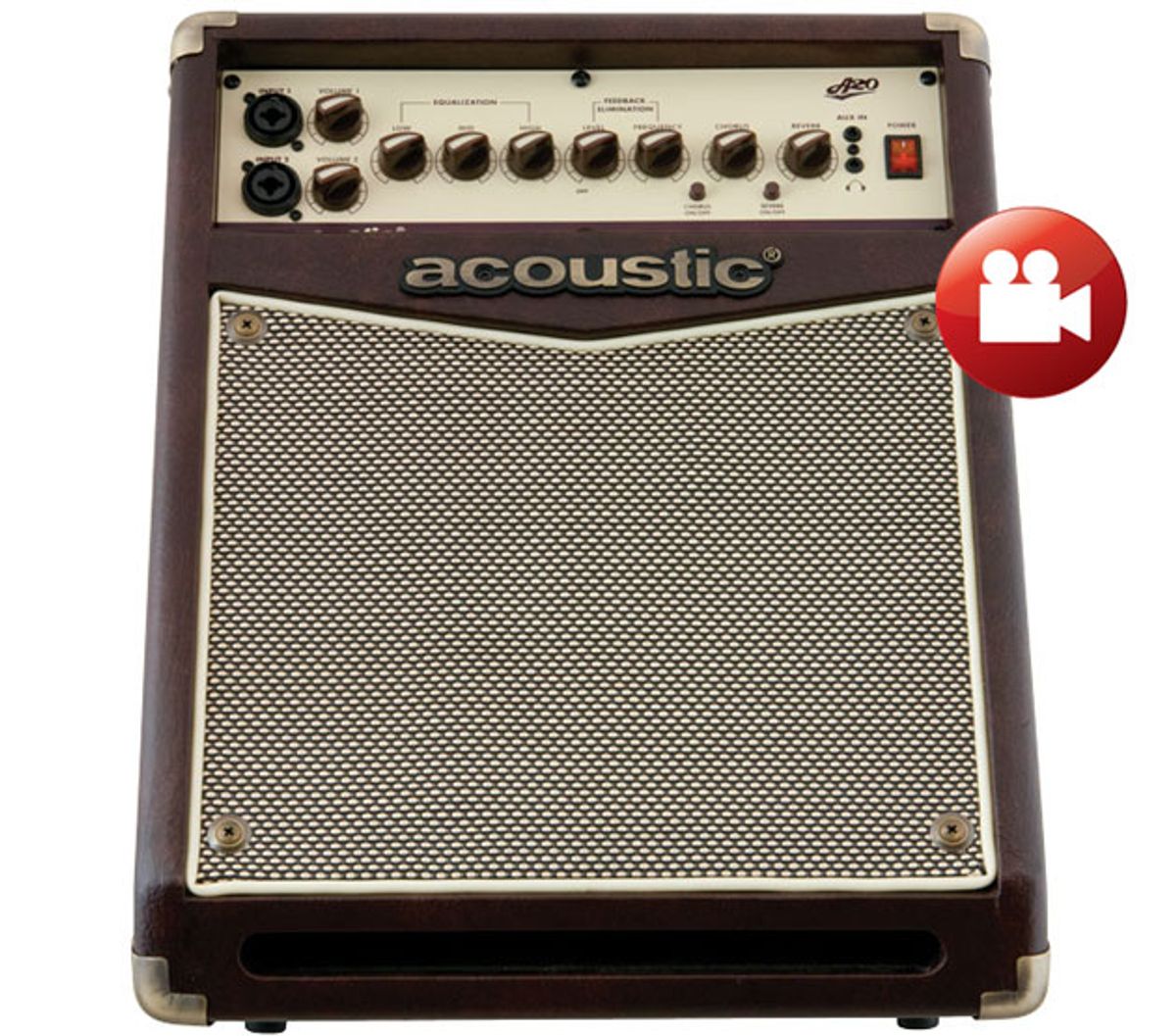This super-affordable amp for flattops exhibits surprising tonal range.
Few musical feats feel so intrinsically like compromise as amplifying an acoustic guitar—especially when you’re trying to do it on a budget. A lot of experienced acoustic players will choose the hit-or-miss proposition of miking their guitars rather than deal with a cheap, dodgy dedicated acoustic amp that sounds like a discarded car-stereo speaker in a shoebox.
Given these grim truths of acoustic performance on a shoestring budget, the fact that Acoustic has managed to deliver the thoughtfully designed and stage-worthy A20 for the price of an inexpensive delay pedal is noteworthy. That it often feels truly musical, organic, and full beyond the boxy, teetering-on-the-verge-of-feedback constraints typical of the breed will be a cause for minor celebration among cash-strapped cafe performers everywhere.
Happiness in Geometry
Most entry-level acoustic-guitar amps could easily be mistaken for budget electric-guitar amps (save for the brown vinyl often used to suggest rusticity and acousto-worthiness). But in the case of the A20 and its bigger cousins, the A40 and A1000, Acoustic chose to forego four right angles in favor of a stage monitor-like pentagonal shape.
The benefits are threefold: improved projection, more accurate and directional monitoring (which can also facilitate performing at lower, less feedback-prone levels), and more ergonomically efficient interaction via easy-to-see controls. It’s also an especially stable amp—a more than fair trade for not being able to perch your drink upon it.
For an amp that’s less than 130 bucks, the A20 is pretty generously appointed with practical features. There are two inputs, so you can add a vocal mic or second instrument, as well as a 3-band EQ and an equally vital set of feedback-elimination controls that enable to you to pinpoint a frequency and adjust the attenuation. Two additional knobs control the level of the onboard chorus and reverb. The backside of the amp includes an XLR out and level control for running your signal to a PA, as well as an effects loop and ground/lift and post-/pre-EQ switches.
Laid Back and Forgiving
I tested the A20 with some very good guitars and transducers, including a new Taylor 600 series with an Expression 2 system, Martin 00-15 and Gibson J-45 flattops with L.R. Baggs Element transducers, and a Martin D-18 with a Trance Audio Amulet M system. So while we can’t say how well the A20 would respond to a cheap undersaddle pickup (even the best acoustic amps can be rendered lousy-sounding by budget pickups), it can certainly communicate the musical nuances of a good pickup system.
Ratings
Pros:
Rock-bottom price. Uncommonly solid low-end for the price. Good feedback resistance. Ergonomic shape works well for monitoring.
Cons:
Inorganic high-mid and treble output. Digital-sounding effects.
Tones:
Ease of Use:
Build/Design:
Value:
Street:
$129 street
Acoustic Amplification A20
acousticamplification.com
The D-18, J-45, and 600 are all big, boomy guitars, but the A20’s 8" speaker communicated the detail of deep, resonant low-end tones, doubles, and octaves in dropped-D and open-G with very little feedback suppression. That feat was doubly remarkable given that the amp was positioned no more than two-and-a-half feet in front of me, with the speaker tilted at a 45-degree angle back at the guitar. If I had any doubts that the A20 could remain feedback resistant in close quarters, this test quelled most of them.
While the A20’s low-end output is pretty robust and colorful, it was more challenging to dial in organic and resonant-sounding mid and high-mid tones. I typically kept the high control around 9 or 10 o’clock with the bigger guitars, and nudged it up just a bit for the smaller, darker-sounding, and less-resonant 00-15. The midrange control also works best in mild doses—too much tends to emphasize the less organic qualities of the signal chain.
The onboard effects work best at low volumes and at lower levels. The tiniest touch of the chorus and reverb together can lend a pleasant sense of animation and dynamics to fingerpicked arpeggios and slow strumming. But the threshold at which the effects reveal their digital nature is fairly low, and those qualities are emphasized exponentially as the volume goes up. Keen effect users will be better off routing their own effects through the onboard effects loop.
The Verdict
Impeccable acoustic amplification is never inexpensive, but it’s hard to imagine a better deal than the Acoustic A20. To be certain, it exhibits some of the shortcomings intrinsic to a budget affair. The high-mid and high-end output lack a little detail and dimension, and tend to sound a little artificial at higher levels. And the onboard effects tend to sound very digital at all but the lowest levels. But the low-end detail and resonance of the A20 is almost startling given the price, and the three EQ controls together are wide-ranging enough that you can definitely capture—and even flatter—the personality of an individual instrument rather than having to rely on a single generic setting.
Watch the Review Demo:

